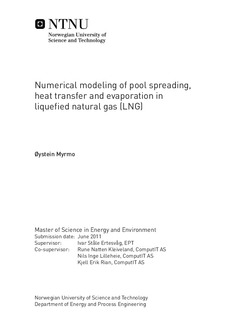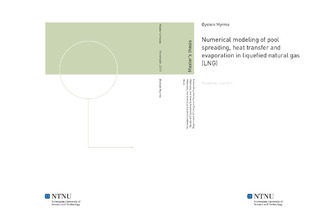| dc.description.abstract | This master's thesis is a continuation of previous theses written at ComputIT AS. It treats heat transfer to LNG pools boiling on water through two heat transfer models, LNGSIM1 and LNGSIM2. LNGSIM1 utilizes heat transfer correlations for pure liquids in combination with physical data of the mixture, while LNGSIM2 uses LNGSIM1 and a simple model for the concentration boundary layer. Both models are implemented in the CFD software Kameleon FireEx (KFX) and thereafter tested and validated against experimental data from the Burro test series. Comparisons with experimental data show that LNGSIM1 often produces correct trends in the downstream gas concentrations. The results are, however, often shifted in time, indicating that the heat transfer in the beginning of the spill is too low. LNGSIM2 is constructed to increase the heat transfer compared to LNGSIM1, hence vaporizing the LNG faster to better fit the experimental data in time. The choice of the constant CSIM2 in LNGSIM2 greatly affects the heat transfer, and it is found to fit experimental data best for 0.70 < CSIM2 < 0.80.An attempt to approximate LNG as pure methane produced erroneous results due to the heat flux remaining constant throughout the spill. Another attempted approximation was the use of a constant heat transfer coefficient. This produced very low heat fluxes towards the end of the spill, making it impossible for the gas concentrations to reach a zero value within the experimental time interval. The use of these simplifications are therefore not advised.A study of rapid phase transitions (RPT) is conducted using a simple criterion for when an RPT can occur. Comparison with a theoretical study gives promising results for describing when, where and why an RPT occur. This can be used to estimate when to release the pressure wave of an RPT.Investigations of the pool boiling correlations for pure liquids conclude that the way of calculating the transition boiling regime results in too high heat fluxes in that regime. To address this, a parameter study using LNGSIM1 and a factor Z is performed in order to reduce the transition boiling heat fluxes. The optimum values of Z are thereafter combined with the optimum values of CSIM2. Combining Z and CSIM2 reveals that most of the investigated values of Z overrides the wanted effect of CSIM2, hence warranting new approaches to reduce the overestimated transition boiling heat fluxes. Nevertheless, LNGSIM1 and LNGSIM2 with 0.70 < CSIM2 < 1.00 appear to be good alternatives to the current heat transfer model in KFX, since the heat transfer coefficient is continuously calculated based on compositions and boiling regimes, whereas the KFX model requires a constant heat transfer coefficient as input. | nb_NO |

